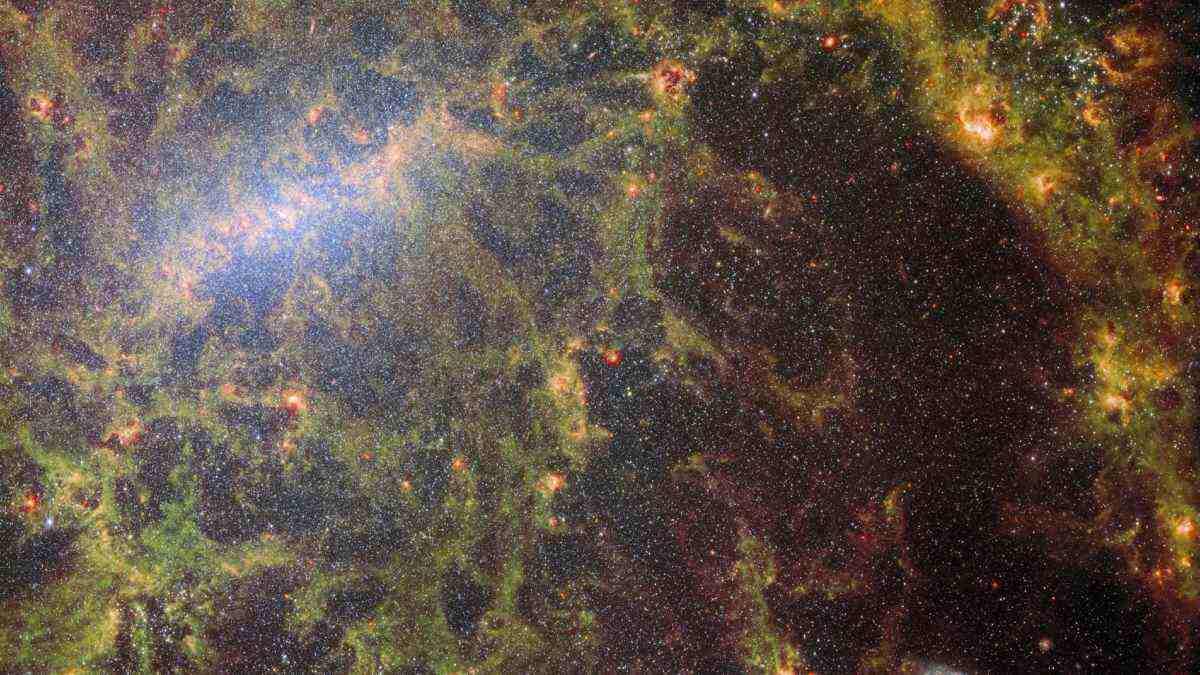UNITED STATES: In a groundbreaking achievement, the James Webb Space Telescope (JWST) has witnessed the birth of new suns in a far-flung galaxy, offering scientists an unprecedented glimpse into the intricate processes of star formation.
The observatory focused its powerful instruments on a remarkable feature—an intricate network of dust and bright star cluster threads—in the galaxy NGC 5068, located approximately 20 million light years away from Earth.
The JWST, renowned for its advanced capabilities, is uniquely suited to unraveling the mysteries of star formation in remarkable detail. NASA, in its quest to understand the inner workings of galaxies, conducted an extensive campaign centered on star formation in nearby galaxies.
This ambitious endeavor involved combining images collected by the Webb telescope with data from other powerful instruments, such as the Hubble Space Telescope, the Very Large Telescope (VLT), and the Atacama Large Millimeter/submillimeter Array (ALMA).
The observations carried out by the JWST were not limited to NGC 5068 alone. Webb’s lenses captured images of 19 nearby star-forming galaxies, which were then meticulously merged with Hubble’s images of 10,000-star clusters.
Additionally, spectroscopic mapping from the VLT illuminated 20,000 star-forming emission nebulae, while ALMA’s observations focused on 12,000 dark, dense molecular clouds. By integrating these diverse datasets, astronomers hope to unlock the secrets behind the initiation of star formation in galaxies.
The JWST’s unparalleled strength lies in its ability to penetrate the veils of gas and dust that enshroud nascent stars. By operating primarily in the infrared part of the electromagnetic spectrum, the telescope gains a unique advantage over visible light observatories.
Infrared light possesses the remarkable ability to traverse interstellar dust, providing astronomers with a clearer view of star-forming regions that would otherwise remain hidden. This capability allows the JWST to capture the faint infrared signals emitted by young stars, thanks to its large segmented mirror that significantly enhances light-gathering power.
Astronomers utilized the Mid-Infrared Instrument (MIRI) and the Near-Infrared Camera (NIRCam) aboard the JWST to directly peer through the colossal clouds of dust within NGC 5068.
Within these seemingly impenetrable barriers, they captured the awe-inspiring processes of star formation as they unfolded, shedding light on the origins of new suns in the galaxy.
Star formation is an essential component of numerous astronomical fields, ranging from the study of interstellar plasma to the evolution of entire galaxies.
The JWST’s unprecedented observations hold the promise of revolutionizing our understanding of these intricate processes, painting a vivid picture of how stars come into existence and shape the cosmos.
As the JWST continues to unveil the mysteries of the universe, scientists eagerly await further discoveries, eagerly anticipating the next chapter in our exploration of the cosmos with this groundbreaking observatory.
Also Read: James Webb Telescope Unveils Giant 9,000km Water Plume on Saturn’s Moon Enceladus



